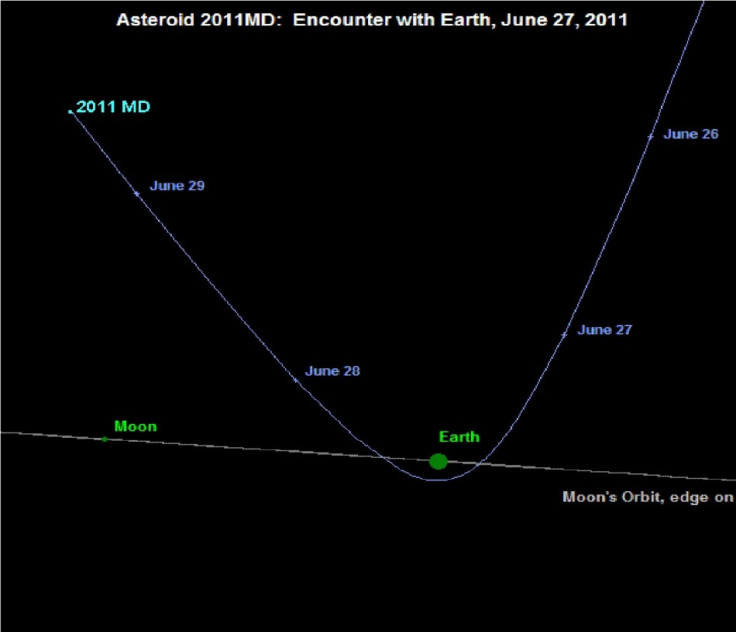Asteroid 2011 MD to Pass Earth as Closely as 7,500 Miles, June 27

Much attention is given to the space these days. Perhaps humans are tired of Earth and desire to grasp the mysterious world outside this planet. Here is yet another chance to catch a glimpse of a spectacle in the sky. This time, the chance may be even slimmer.
An asteroid measuring 16 to 35 feet will fly by Earth on Monday, with possible viewing opportunities for a lucky few.
With an orbit similar to Earth's, the asteroid will make the closest approach at 9:30 a.m. EDT on June 27, passing over 7,500 miles (12,000 kilometers) above the Earth's surface, according to NASA officials. At that particular moment, the asteroid, which scientists have named 2011 MD, will be sailing high off the coast of Antarctica, almost 2,000 miles (3,218 km) south-southwest of South Africa.
At that time, the asteroid is approximately 30 times closer to Earth than the existing distance between the planet and the moon, which is around 240,000 miles.
According to the ranking charts of International Astronomical Union's Minor Planet Center in Massachusetts, 2011, MD will be the fifth-closest asteroid to graze past Earth. In the past, three asteroids have zoomed past Earth at a closer distance, including a tiny asteroid (2011 CQ1) which flew by on February 4 this year after coming as close as 3,400 miles away from Earth's surface. The fourth, an asteroid named 2008 TC3 had entered Earth's atmosphere on October 7, 2008, but disintegrated into tiny pieces at a distance of around 23 miles off the ground.
Fred Watson from the Australian Astronomical Observatory says there won't be much of a spectacle. But amateur astronomers are still hoping to catch a glimpse of the stunning blue light in the sky.
According to space.com, 2011 MD will be visible in moderately-large amateur telescopes for several hours prior to its closest approach. Despite its close approach, viewing this asteroid is unlikely an easy task.
These objects are so small that normally a sizeable telescope is required, Asteroid Watch scientists warned.
You will need to have access to an excellent star atlas. Because of its rapid movement, you will also need the very latest data from the Minor Planet Center to track its precise course against the background stars. The asteroid is not expected to get very bright; about 250 times dimmer than the faintest stars visible to the eye without optical aid, space.com stated.
According to calculations by Astro Bob, many people will be able to see the asteroid come close to the Earth but only a lucky few will be able to witness it when the asteroid will be closest to the Earth's surface.
Closest approach happens around 8:30 a.m. CDT Monday over the far South Atlantic Ocean off the coast of Antarctica. Observers in Australia and New Zealand will be able to catch it in their telescopes at around magnitude 12 about a half hour before closest shave.
In the Midwest, the asteroid will be visible as a faint 14.5 magnitude speck moving at a respectable pace across the stars of Serpens low in the western sky in the early morning hours Monday, Bob King said on Astro Bob site.
Astro Bob has recommended sky-gazers to use at least an 8-inch or larger scope to spot 2011 MD.
If a rocky asteroid the size of 2011 MD were to enter Earth's atmosphere, it would be expected to burn up high in the atmosphere and cause no damage to Earth's surface, according to NASA's Asteroid Watch.
NASA said asteroids of the size of 2011 MD come this close to Earth on average of once every six years.
NASA scientists say the Earth is surrounded by 8,099-odd known asteroids or Near-Earth Objects (NEO) of different sizes, whose orbits are dangerously close to the earth's surface. Of them, only around 1,000 measure less than 100 feet across, about 827 are asteroids with a diameter of half a mile or longer and about 1236 of them have been classified as Potentially Hazardous Asteroids.
In 2016, NASA will launch the OSIRIS-Rex asteroid probe that will visit a potentially dangerous NEO called 1999 RQ36 in 2020. 1999 RQ36 is 1,900 feet wide and scientists say it has a 1-in-1,800 chance of hitting Earth in the year 2170, and a 1-in-1,000 chance of crashing into us in 2182.
Fred Watson from the Australian Astronomical Observatory was quoted by ABC News, The closeness of 2011 MD is a reminder to people that events on Earth have the potential to be shaped by asteroids - 'like the annihilation of the dinosaurs'. It reminds us of our reality in an environment littered with debris of this kind, which is actually the leftovers of the solar system's formation about 4.6 billion years ago, Watson said.
Astronomers are keeping a close eye on an asteroid called Apophis, which will come very close to Earth in 2029, Watson said.
In 2029 there is one that will pass very close to the Earth but probably won't hit the Earth. But depending on how near the Earth it goes, it might be deflected into an orbit that will take it onto a collision course, probably in the 2030s. [Life's] a little more thrilling this way. It's not impossible that something will collide with the Earth in the future. There are objects we know will present a potential threat, continued Watson.
© Copyright IBTimes 2024. All rights reserved.





















